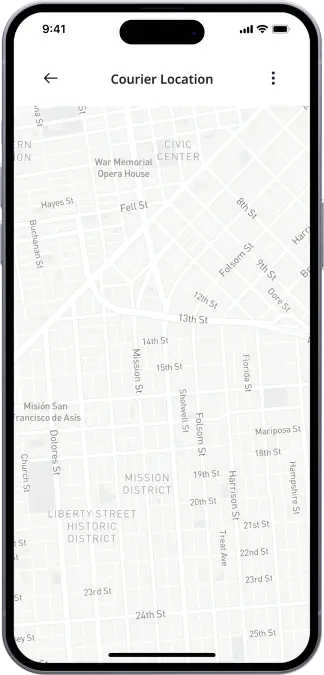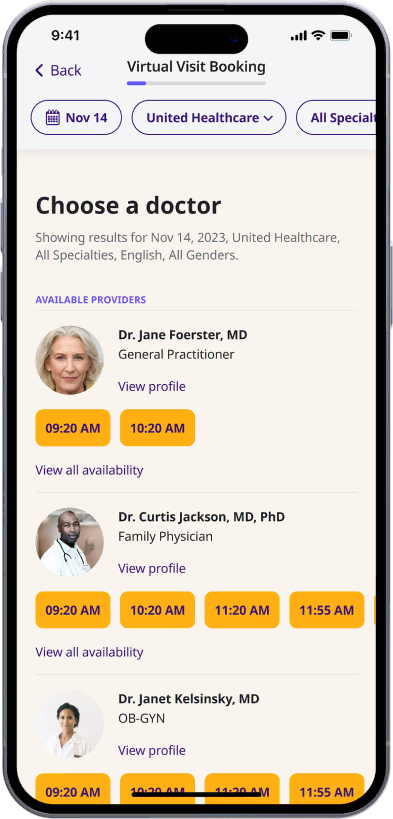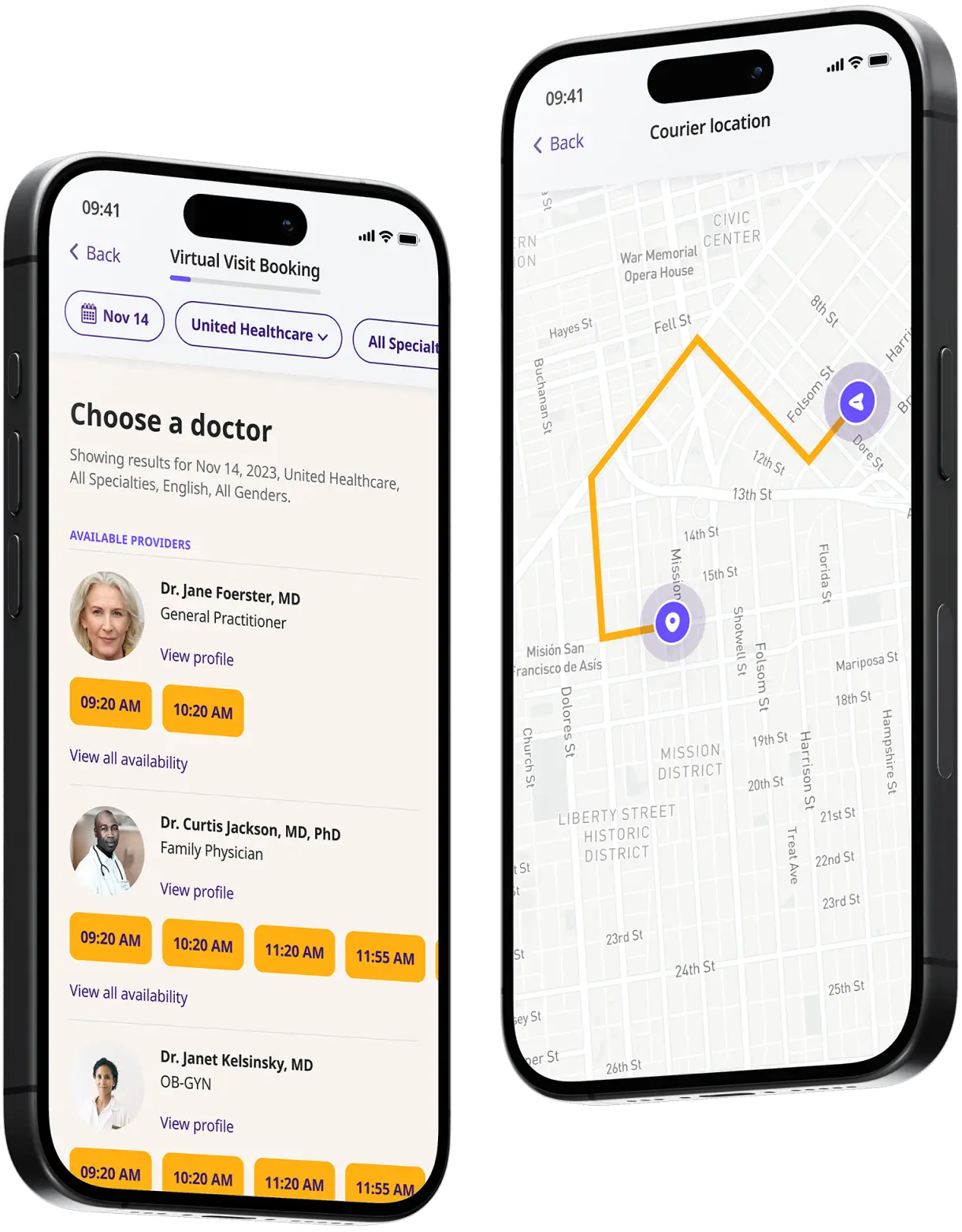Stomach Pain & Discomfort Treatment Online
Find relief from stomach pain and bloating. See an online doctor 24/7 for cramps, indigestion, and discomfort.


Available in 50 states. Insurance accepted.
Fast
virtual visits
24/7 care
assistants
Prescriptions
as needed

24/7 Personal Care
Consult with a physician in 15 minutes, refill an Rx or chat with our care assistants.

Affordable & Convenient
See your cost upfront and get treatment for hundreds of different conditions.

Insurance Accepted
We accept most major insurance plans, making healthcare easy and affordable.
See If Delivery Is Available Near You
Delivery Not Available
Enter your ZIP code to check if prescription delivery is available in your area and how soon your meds could arrive.
How to get started
Choose your doctor, start a virtual visit, and have your prescriptions sent to your preferred pharmacy for pickup — all in just a few easy steps.
Choose a doctor
Choose a physician by availability, specialty, ratings, and more.

Start your video visit
Connect with a doctor in minutes on a secure video call.

Get your prescription
Pick up your meds or have them delivered in as little as an hour.

Available in 50 states. Insurance accepted.
One-Time
Physician Visit
One-time visit with a physician for diagnosis, treatment, Rx, labs, referrals, and doctor’s notes.
Accepted Insurances
See why people turn to DrHouse...
As seen in

Stomach Pain & Discomfort Treatment Online
Abdominal pain and discomfort can range from mild and temporary to severe and chronic, significantly affecting an individual’s quality of life. This condition, commonly referred to as stomach pain, is one of the most frequent complaints in all age groups and a common reason for visits to healthcare providers, both in-person and online.
Abdominal pain can be categorized based on various factors such as duration, location, and intensity.
Acute abdominal pain develops suddenly and can range from mild discomfort to intense pain, often necessitating immediate medical attention.
Chronic abdominal pain, on the other hand, may be intermittent or continuous and lasts for several months or longer, indicating a potentially underlying medical condition that requires ongoing management.
Location is also key in diagnosing abdominal issues; pain may be localized to one area of the abdomen or be more diffuse. The nature of the pain—whether it’s a dull ache, a sharp, stabbing sensation, or cramping—also provides clues to the underlying causes.
Types of abdominal pain
Abdominal pain types are generally categorized by onset, duration, and location, each providing critical clues to the underlying health issues.
- Visceral pain: This type of pain arises from the internal organs, or viscera. It is often described as diffuse or vague and not well localized. Visceral pain is typically a result of organs stretching abnormally due to inflammation, distension, or loss of blood supply. Common conditions that cause visceral pain include gastroenteritis, irritable bowel syndrome (IBS), and urinary tract infections.
- Parietal pain: Also known as somatic pain, parietal pain occurs when pain receptors in the abdomen’s lining (peritoneum) are activated. Unlike visceral pain, parietal pain is more localized and intense, often allowing patients and doctors to pinpoint more accurately the area of distress. Conditions such as appendicitis or peritonitis typically cause this type of pain.
- Referred pain: This pain is perceived at a location other than the site of the painful stimulus. An example is gallbladder pain which may be felt in the right shoulder. Referred pain occurs because of the network of nerves that the body uses to convey pain signals.
- Functional pain: This type refers to abdominal pain without clear evidence of an underlying medical condition. Functional abdominal pain syndromes, such as functional dyspepsia or functional abdominal pain in children, are common and can be chronic and challenging to treat.
- Colicky pain: This type of pain occurs in waves. It starts and ends suddenly and is often severe. Bowel obstructions and kidney or gallstones typically cause colicky pain as the smooth muscle in the hollow organs contracts vigorously to relieve an obstruction.
Causes of stomach pain and discomfort
Stomach pain and discomfort can be caused by a myriad of factors that range from benign to severe.
Common causes include dietary choices such as overeating or consuming spicy and fatty foods, which can lead to temporary discomfort or indigestion. Other factors include stress and anxiety, which can exacerbate gastrointestinal symptoms due to the gut-brain connection.
Infections, such as those caused by bacteria or viruses, can lead to stomach pain and are often accompanied by other symptoms like fever, vomiting, and diarrhea. Additionally, the use of certain medications, such as nonsteroidal anti-inflammatory drugs (NSAIDs), can cause stomach pain by irritating the stomach lining or worsening existing conditions like ulcers.
Chronic conditions also play a significant role in recurrent or persistent abdominal pain. Conditions such as lactose intolerance or other food intolerances, celiac disease, and inflammatory bowel diseases (like Crohn’s disease and ulcerative colitis) can lead to ongoing discomfort and require long-term management strategies.
Common medical conditions that can cause abdominal pain or discomfort
Several medical conditions can lead to abdominal pain or discomfort, ranging from temporary and benign to chronic and severe. Here’s a detailed look at some common conditions:
- Gastroesophageal reflux disease (GERD): This condition involves the backflow of stomach acids into the esophagus, causing heartburn, chest pain, and potentially leading to complications such as esophageal damage. Chronic GERD can cause significant discomfort and may require lifestyle changes and medication.
- Irritable bowel syndrome (IBS): Characterized by a combination of symptoms including intermittent pain, bloating, and changes in bowel habits (constipation or diarrhea), IBS is a functional gastrointestinal disorder with no identifiable cause. Management involves dietary adjustments, stress management, and sometimes medication.
- Peptic ulcers: These are sores that develop on the lining of the stomach, small intestine, or esophagus. They are often caused by Helicobacter pylori infection or long-term use of NSAIDs. Symptoms include burning stomach pain, bloating, and heartburn.
- Appendicitis: This acute condition involves inflammation of the appendix and is a medical emergency. It causes severe pain in the lower right abdomen and requires surgical removal of the appendix.
- Pancreatitis: Inflammation of the pancreas can cause upper abdominal pain that radiates to the back. It can be acute or chronic and may require hospitalization for management of pain, hydration, and sometimes surgery or other interventions.
- Gallstones: Hard particles that form in the gallbladder can cause sudden and severe pain known as biliary colic. Treatment may involve medication to dissolve the stones or surgery to remove the gallbladder.
- Diverticulitis: Inflammation or infection of small pouches that can form in the walls of the colon. Symptoms include pain, fever, and changes in bowel habits, with treatment options including antibiotics, a liquid diet, or surgery.
- Lactose intolerance: This is an inability to digest lactose, a sugar found in milk and dairy products, causing symptoms like bloating, diarrhea, and gas after consuming dairy.
- Inflammatory bowel disease (IBD): This term encompasses chronic conditions like Crohn’s disease and ulcerative colitis, which involve chronic inflammation of the gastrointestinal tract. Symptoms and treatments vary widely but often include anti-inflammatory drugs and immune system suppressors.
Abdominal pain symptoms
Abdominal pain is a common symptom that can vary greatly in terms of intensity, location, and accompanying features.
Recognizing these symptoms is crucial for identifying the underlying causes and deciding on the appropriate course of treatment. Symptoms can be acute, appearing suddenly and severely, or chronic, persisting over a longer period.
Here’s a detailed overview of common abdominal pain symptoms that help in diagnosing the potential issues:
- Localized pain: When pain is confined to one area of the abdomen, it often indicates a problem in a specific organ. For example, pain in the right lower quadrant could suggest appendicitis, while pain in the upper right quadrant might indicate issues with the gallbladder like gallstones.
- Generalized pain: This type of pain occurs more broadly across more than half of the abdominal area and can suggest a viral infection, indigestion, or even gas. If the pain becomes more intense, it may indicate a more serious issue, such as a blockage in the intestines.
- Cramping: Often not severe and likely to be caused by gas and bloating. This type of pain is usually temporary and may resolve without treatment. Persistent or severe cramps, however, may require medical attention as they can be a sign of a more significant problem.
- Sharp, piercing pain: This can indicate a severe condition and is most concerning when it starts suddenly and intensely. Conditions like a ruptured appendix, perforated stomach ulcer, or ectopic pregnancy (in women) can manifest as sharp, stabbing pain and require immediate medical attention.
- Colicky pain: This is a symptom of conditions like kidney stones or gallstones. The pain typically comes in waves, starting and stopping abruptly, and can be excruciating.
Accompanying symptoms: The nature of abdominal pain can often be further elucidated by accompanying symptoms. For instance:
- Nausea and vomiting: These symptoms often accompany a stomach virus, food poisoning, or gastritis.
- Fever: Suggests an infection or inflammation, seen in conditions like appendicitis or diverticulitis.
- Jaundice: The yellowing of the skin and eyes can be associated with liver problems or gallstones.
- Changes in bowel movements: Constipation, diarrhea, or changes in the color and consistency of stool can indicate gastrointestinal disorders.
- Bloating: Often associated with digestive issues, bloating can also suggest hormonal imbalances or food intolerances.
How to treat abdominal pain or discomfort
Treating abdominal pain or discomfort effectively requires a tailored approach based on the underlying cause, the severity of the symptoms, and the individual’s overall health.
Here are some general strategies and specific treatments often recommended for managing various types of abdominal pain:
- Lifestyle modifications: Many cases of mild abdominal pain can be managed with simple lifestyle changes. This includes eating smaller, more frequent meals, avoiding spicy and fatty foods, and reducing caffeine and alcohol intake. Incorporating a balanced diet rich in fiber can help prevent constipation and promote a healthier digestive tract.
- Hydration: Staying well-hydrated is essential, especially if the abdominal pain is accompanied by diarrhea or vomiting, which can lead to dehydration. Drinking clear fluids such as water, diluted fruit juices, or broth can help maintain hydration levels.
- Heat therapy: Applying a heating pad or a hot water bottle to the abdomen can help relax and soothe muscles, which may alleviate pain caused by cramps or tension.
- Over-the-counter (OTC) Medications: For immediate relief, OTC medications such as antacids, anti-gas products, or nonsteroidal anti-inflammatory drugs (NSAIDs) can be used to manage symptoms. However, it is crucial to use these medications as directed and consult with a healthcare provider if symptoms persist.
- Rest: Adequate rest is important, as it helps the body to recover more quickly and effectively from any underlying issues that might be causing the pain.
- Probiotics: These can help restore the natural balance of bacteria in your gut, particularly if your abdominal pain is related to antibiotic use or gastrointestinal infections.
- Avoiding trigger foods: If specific foods trigger symptoms, keeping a food diary to track what you eat and how it affects your body can be helpful. Eliminating trigger foods may significantly reduce or eliminate pain.
- Medical treatments: For more severe or chronic abdominal pain, such as that caused by conditions like ulcers, GERD, or inflammatory bowel diseases, prescription medications may be necessary. Additionally, if an infection is the cause, antibiotics will be prescribed.
Abdominal pain medication
When lifestyle adjustments and home remedies are not enough to alleviate abdominal pain, various medications can be used depending on the underlying cause:
- Antacids and acid blockers: These medications, such as ranitidine or omeprazole, are used to treat pain related to ulcers or GERD by reducing stomach acid levels.
- Antispasmodics: For cramping and pain due to disorders like IBS, medications that relax the muscles of the intestines, such as dicyclomine, can be effective.
- Antimotility drugs: To help manage diarrhea and the discomfort that comes with it, antimotility medications like loperamide can reduce the frequency of bowel movements.
- Antibiotics: If an infection, such as diverticulitis or a gastrointestinal infection, is causing the pain, antibiotics may be prescribed to fight the infection.
- Pain relievers: For general relief, pain relievers like acetaminophen can be used; however, NSAIDs should be used cautiously as they can irritate the stomach and lead to further discomfort or complications.
- Corticosteroids: For inflammatory conditions like Crohn’s disease or ulcerative colitis, corticosteroids can help reduce inflammation.
- Biologic therapies: Advanced treatments like biologics are used for certain types of IBD and target specific components of the immune system to prevent inflammation that can cause pain.
How can DrHouse help?
DrHouse is a telehealth app designed to simplify access to healthcare, providing users with the tools needed to address abdominal pain and other health concerns efficiently. Through the app, users can consult licensed healthcare professionals via a video call, allowing for timely evaluation and management of their symptoms from the comfort of their homes.
DrHouse offers personalized health assessments where users can describe their symptoms, receive guidance on potential treatments, and have prescriptions sent directly to their pharmacies if necessary.
If you are experiencing abdominal pain or discomfort and are unsure of the cause or the best course of action, DrHouse can be a valuable resource in providing timely and convenient healthcare. Download the app today to take control of your health and get relief from abdominal pain.
Related services
Explore more of our services tailored to your needs and discover additional ways we can support your healthcare needs.
Frequently asked questions




